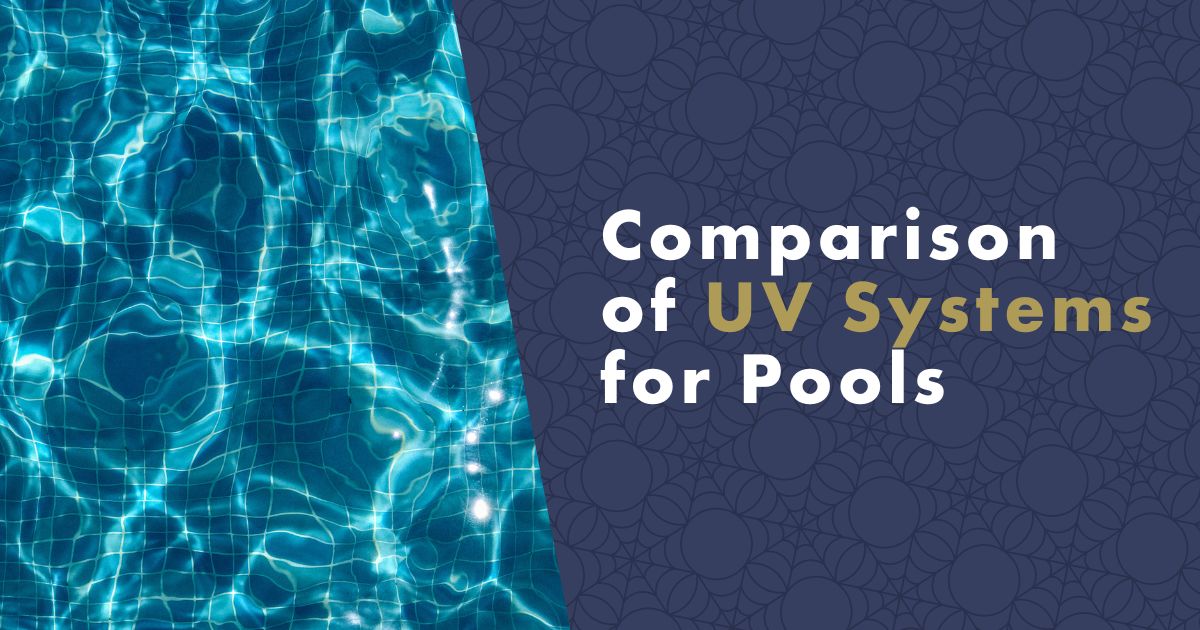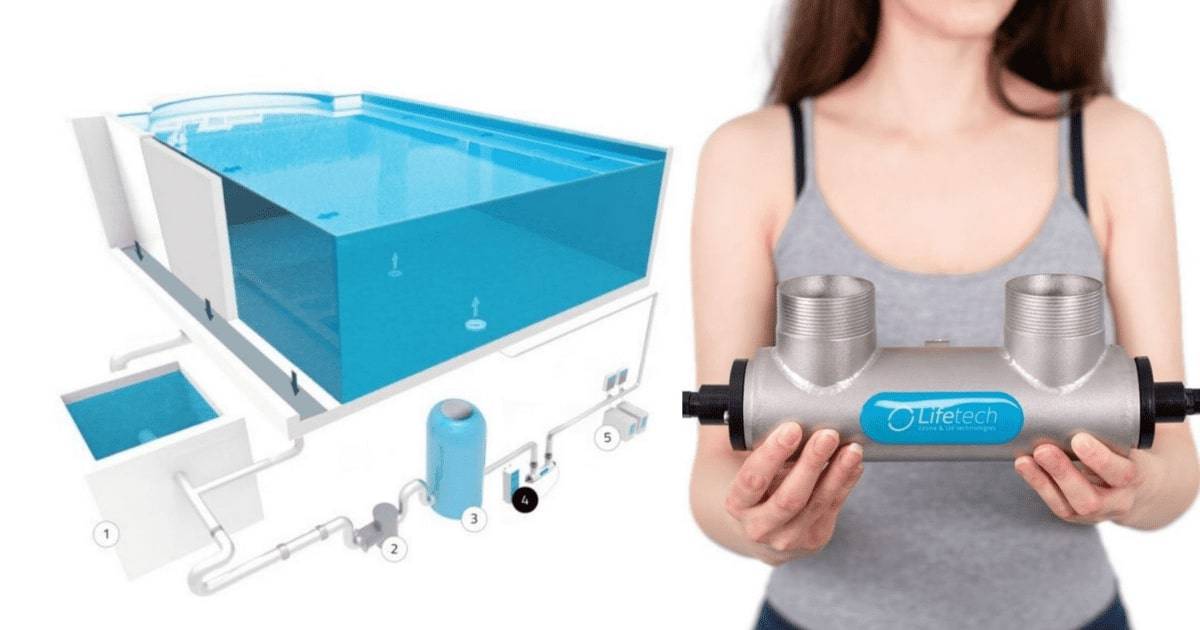UV disinfection has become an increasingly sought-after alternative to traditional chemical water treatment in recent years. It is commonly used for treating both pool and drinking water. Unlike chlorination, UV disinfection does not result in the formation of harmful compounds. Medium-pressure UV systems can also eliminate toxic trichloramine and chloro-resistant bacteria.
Both low-pressure and medium-pressure UV systems utilize ultraviolet radiation to purify water. However, the technologies they employ differ significantly.

Why Is UV Light Used for Disinfection?
Although UV light is invisible to the naked eye, humanity has managed to harness it. Gradually, it was discovered that short-wavelength UV radiation can cause microbial breakdown. It was only a small step from there to the first successful use of UV light for water treatment, which occurred in the USA in 1916.
Tip: Beware of "unknown" health risks in pools. We know how to deal with them
Today, we know that there are three different wavelengths of UV light: UV-A, UV-B, and UV-C. However, only UV-C light is suitable for effective disinfection.
Main advantages of water disinfection with UV radiation:
- reaction time on the order of seconds
- no need for a reaction vessel
- low operating costs
- no change in the original water composition
- treatment does not alter the taste or odor of the water
- no harmful by-products are created as a result of disinfection
So how do modern UV systems actually work? Of course, we could write a very extensive technical paper on this topic, but the basic operating principle is relatively simple.
The cornerstone of a UV system is a special germicidal lamp that converts electricity into the desired ultraviolet radiation. Water continuously flows through the UV lamp chamber, where it is exposed to the emitted UV light. Essentially, the radiation rearranges the information stored in the DNA of microorganisms, rendering the cell unable to replicate further.
Subsequently, due to UV radiation, there is gradual destruction and complete breakdown of bacteriological impurities, ensuring that the water remains transparently clean. Modern UV systems are simply a green alternative to traditional disinfectant chemicals.
Differences between Low-Pressure and Medium-Pressure UV Systems
When disinfecting with UV radiation, a simple rule applies: the wider the spectrum of wavelengths a UV system can emit, the more effectively it will eliminate pathogenic organisms. The reason is simple. Each substance and microorganism is destroyed and decomposed by different wavelengths. Treating water with broad-spectrum UV-C radiation will inevitably remove more harmful substances.
And that's where the biggest difference between low-pressure and medium-pressure UV systems lies. Low-pressure lamps can emit UV radiation only at a wavelength of 253.7 nm. In contrast, medium-pressure UV systems emit a wide range of wavelengths within the entire germicidal UV range, ranging from 200 to 600 nm.
#produkty#https://www.nanospace.store/search/?string=UVM
Simply put, medium-pressure UV systems remove the same contaminants from water as low-pressure UV systems, but they can also eliminate a wide range of additional substances.
Of course, the two technologies also differ in their design. Inside low-pressure UV lamps, a vacuum is created first (they are evacuated) and then filled with low-pressure gas. As a result, the lamp's pressure ranges from 1 to 10 mbar. Medium-pressure UV lamps are evacuated to 1 to 5 bar during production and are subsequently filled with gas, further increasing the lamp's pressure.
Medium-Pressure UV Systems Eliminate Bacteria and Toxic Trichloramine
If you have experience with low-pressure UV systems, you probably know that their effectiveness is not ideal. Microbes have developed an efficient natural defense mechanism over millions of years to survive increased UV radiation. For this reason, some microorganisms are exceptionally resilient. With the help of light and special enzymes, they undergo a process called photoreactivation, repairing damaged DNA, allowing them to recover and continue to thrive in the water.

It is often mentioned with concern in connection with UV technologies that the possibility of microbe reactivation after disinfection with low-pressure UV radiation. Anyone using UV radiation for water disinfection wants to be absolutely sure that water treatment is reliable and, above all, permanent. Low-pressure UV systems cannot provide such a guarantee.
That's why the latest version of the German standard DIN 19643 for swimming pool water treatment clearly states that only UV-M (medium-pressure UV systems) can effectively disinfect pool water and reduce the content of bound chlorine, including dangerous trichloramine.
Tip: Trichloramine: The Hidden Danger in Your Swimming Pool
The decision about this standard is certainly not random. There are studies that demonstrate that medium-pressure UV radiation, composed of multiple wavelengths, does indeed cause irreparable damage to microorganisms. In addition to DNA and RNA, it reliably destroys enzymes and cellular proteins, preventing reactivation, which means microbial elimination is permanent.
Main advantages of medium-pressure UV systems:
- water disinfection is permanent
- removes chlorine-resistant bacteria from water (Cryptosporidium parvum and Giardia lamblia)
- can eliminate toxic trichloramine and its unpleasant "pool" odor
- reduces the use of pool chemicals
- does not irritate the eyes, skin, or mucous membranes
- reduces the risk of asthma in children
- ideal water treatment solution for allergy sufferers, asthmatics, atopic individuals, and young children
- low operating costs (even lower than traditional UV systems)
- environmentally friendly and "green" water disinfection solution
- easy installation and low maintenance
A (R)evolution in the Lifespan of Medium-Pressure UV Systems
For a long time, the significant weakness of medium-pressure UV systems was their shorter lifespan. Even today, common broad-spectrum (UVM) lamps with standard magnetic ballasts typically last only about 4,000 to 8,000 hours of operation. The number of lamp starts also affects the lifespan. Frequent on-off cycles shorten it. For this reason, many manufacturers consider the number of UVM lamp cycles in their warranty conditions.
When installing medium-pressure UV systems, you must also pay attention to the minimum flow rate around the lamps to ensure continuous cooling. Setting that automatically turns off the lamp if flow stops is also essential, as otherwise, reactor overheating can occur.
Today, there are modern medium-pressure UV systems on the market with significantly longer lifespans. The credit goes to the Czech company Lifetech, which is rightfully recognized worldwide as an expert in ozone, UV, and AOP technologies (AOP = advanced oxidation processes). The company has developed advanced electronic power supplies with the unique LifeAGE® technology, which has significantly extended the lifespan of medium-pressure LifeUVM® lamps.
What does this mean in numbers? Medium-pressure UVM systems from Lifetech will reliably serve you on average for 18,000 hours. However, users proudly report installations where UV lamps have been in operation for up to 30,000 hours, setting new records. It seems that the biggest weakness of medium-pressure UV systems has been successfully addressed.
References and Literature
- Potential repair of Escherichia coli DNA following exposureto UV radiation from both medium- and Iow-pressure UV sources used in drinking water treatment
- IJpelaar, G.F., Harmsen, D.J., Beerendonk, E.F., van Leerdam, R.C., Metz, D.H., Knol, A.H., Fulmer, A. and Krijnen, S., 2010. Comparison of low pressure and medium pressure UV lamps for UV/H2O2 treatment of natural waters containing micro pollutants. Ozone: science & engineering, 32(5), pp.329-337.
- Clancy, J.L., Bukhari, Z., Hargy, T.M., Bolton, J.R., Dussert, B.W. and Marshall, M.M., 2000. Using UV to inactivate Cryptosporidium. Journal‐American Water Works Association, 92(9), pp.97-104.
- Campbell, A.T., Robertson, L.J., Snowball, M.R. and Smith, H.V., 1995. Inactivation of oocysts of Cryptosporidium parvum by ultraviolet irradiation. Water Research, 29(11), pp.2583-2586.
- MeiTing, G.U.O., Huang, J., HongYing, H.U. and WenJun, L.I.U., 2011. Growth and repair potential of three species of bacteria in reclaimed wastewater after UV disinfection. Biomedical and Environmental Sciences, 24(4), pp.400-407.
- Guo, M., Hu, H., Bolton, J.R. and El-Din, M.G., 2009. Comparison of low-and medium-pressure ultraviolet lamps: Photoreactivation of Escherichia coli and total coliforms in secondary effluents of municipal wastewater treatment plants. Water research, 43(3), pp.815-821.

